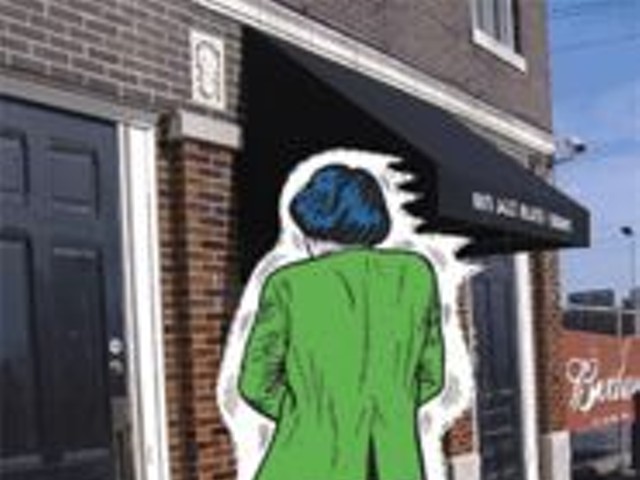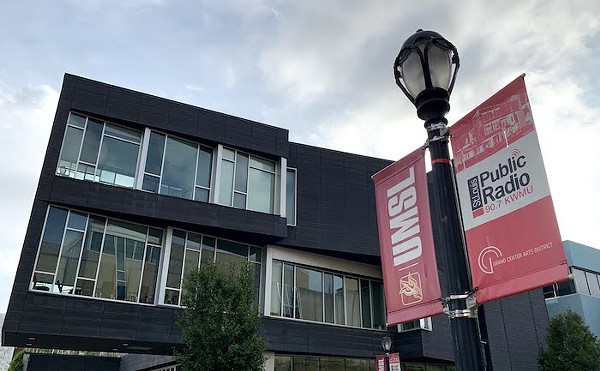"My impulse as an artist," Scott says, "was to ask the question of how we can open that traffic up so it's a place where people feel like they can speak to one another — a place where people feel good to be on the street and safe to be on the street."
The face of Cherokee Street is changing. Over the past five years, the area has attracted a mix of activists and artists drawn by its cheap rent and bustling streetscape. Art galleries have crept in, along with music stores and venues, a vegetarian restaurant, and a bakery. Included in all this is a thriving Hispanic population and a solidly entrenched African-American community.
Scott, a member of this burgeoning bohemian enclave and recipient of a 2005 Grand Center Visionary Award, sought to embrace the evolving Cherokee district with her artwork. She cut through significant amounts of red tape to secure permits. She paid $200 for a vendor's license. She enlisted neighborhood kids to help, and she completed the project in time for Cinco de Mayo.
Then along came Shirley Wallace, the vice president of the Cherokee Station Business Association, who took it upon herself to tear down much of the artwork — during a driving rainstorm — just three days after the festival ended. Harry Bennett, a member of the St. Louis Development Corporation, watched approvingly from a nearby car.
Before beginning the project, Scott contacted Mike Lacy, manager of the National Rent-to-Own store that owns the building she chose for the artwork. Lacy happily signed off.
Scott then called Wallace, who in recent years has gained a less-than-stellar reputation among many business owners. In the past year, she has fought efforts to allow a Mexican bus line to pick up passengers on Cherokee and has alienated potential bar owners by supporting a liquor-license moratorium.
"I intentionally involved Shirley in the process," Scott explains. "I tried to get to know her by asking for her help." Scott says Wallace initially balked but ultimately cooperated by telling the artist what permits she needed.
Scott obtained the necessary city permits — including one that allowed for a temporary two-day installation — and set to work. Her inspiration was the hand-painted signs that hang outside local businesses.
"A lot of times, those symbols had to do with caricatures that directly represented the stores inside," the artist says. She carved silhouettes of these symbols out of foam and titled her work The Acknowledge Project.
Scott started hanging the piece on May 5, first affixing the word "Acknowledge" to the crumbling brick wall in big block letters. She hung a few other symbols: a green alien's head, an Indian head, a pair of eyes.
The next morning — the first day of the festival — Wallace called Scott and demanded that she stop work immediately. Wallace then showed up and "refused to acknowledge the paperwork," Scott recalls. Wallace walked away, and that's the last Scott saw of her that weekend.
For the next two days, Scott and a group of neighborhood children and their parents continued work on the installation, located at the corner of Cherokee Street and Texas Avenue. When The Acknowledge Project was complete, Scott, who was leaving town for a few days, asked National Rent-to-Own's Lacy whether the piece might become permanent. Lacy agreed. Scott then petitioned other area business owners, who also liked the idea.
Several days after Cinco de Mayo, Sheri Ford, owner of punk boutique Tension Head (which is located across the street from the artwork), attended the monthly Cherokee Business Association meeting.
"I had heard rumors that [Wallace] was putting up a big fuss about it," Ford recalls. "I thought, 'That's not her business.' I specifically went to see if there was going to be an issue." But the subject never came up.
An hour after the meeting ended, however, Wallace arrived at the site and started ripping down the art. Scott's two-day permit had expired. Wallace had a grin on her face, remembers Ford.
"This woman," the Tension Head owner adds, "is out there in the rain with garbage bags taking this down, and won't stop." Ford says she insisted that Wallace leave the artwork hanging. "Her comment was that she was doing us a favor by not destroying the pieces. By putting them in trash bags, she was saving it for us."
Ford called friends, who videotaped Wallace in action. She told Lacy, who also demanded that Wallace stop tearing the project down, since it was on his company's property. Ford says she approached Harry Bennett.
"He said that what she was doing was right," Ford recalls. "He wouldn't stop her."
Halfway through removing the art, Wallace stopped and drove away. (Bennett declined to be interviewed for this article.)
Wallace, manager of Haffner's Antiques on Cherokee, says the controversy is being fueled by "a group of people who like to stir up trouble. I'm not interested in participating in it."
Last week Scott called together a group of business owners and residents. Wallace was invited but did not attend. The group addressed the division that exists between the two business associations — the Cherokee Business Association to the west of Jefferson Avenue and the Cherokee Antique Row Merchants Association to the east.
"The block is divided up in a way that perpetuates these divisions," says Scott.
Antique Row Merchants Association president Barb Moore acknowledges the schism but says it's not as distinct as some may think. "Things are changing. You can't be an island," she says. "If Cherokee wants to survive, we all have to work together."
Cherokee Business Association President Robin Strathmann declined to comment for this story.
At the meeting, business owners agreed that Wallace was the key divider and pointed out that she doesn't even own a business or property in the Cherokee neighborhood.
Shangri-La's Celeste Webster recalls a recent run-in with Wallace. Webster and the diner's owner, Patrice Mari, decided to repaint their red-white-and-blue fire hydrant with green paisley. Webster says Wallace confronted them and called the police.
"Within five minutes," Webster recalls, "there was a police officer standing there wishing he was anywhere else." The cop proceeded to call his supervisor, who then contacted the St. Louis Water Division, which granted Webster and Mari permission to keep painting.
Fort Gondo owner Galen Gondolfi, meanwhile, says Wallace accused him of selling drug-laced gumballs. He countered that he had purchased the candy at nearby Globe Drugs.
Scott plans on leaving what remains of the installation intact, which suits Cherokee business owners just fine. There are no plans to file charges against Wallace for trespassing or for destruction of property. During the rainstorm demolition, Wallace didn't have a ladder and was unable to reach the upper half of the installation. As a result, an important part of Scott's artwork remains. It hangs just below the green alien's eyes and lords over the neighborhood like a command: "Acknowledge."





